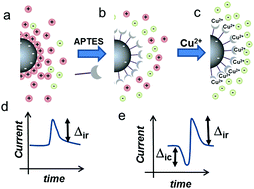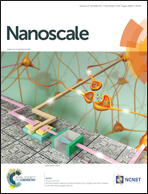A tunable nanopore sensor for the detection of metal ions using translocation velocity and biphasic pulses†
Abstract
A tunable resistive pulse sensor, utilising a polyurethane nanopore, has been used to characterise nanoparticles as they traverse the pore opening. Herein we demonstrate that the translocation speed, conductive and resistive pulse magnitude, can be used to infer the surface charge of a nanoparticle, and act as a specific transduction signal for the binding of metal ions to ligands on the particle surface. Surfaces of silica nanoparticles were modified with a ligand to demonstrate the concept, and used to extract copper(II) ions (Cu2+) from solution. By tuning the pH and ionic strength of the solution, a biphasic pulse, a conductive followed by a resistive pulse is recorded. Biphasic pulses are becoming a powerful means to characterise materials, and provide insight into the translocation mechanism, and herein we present their first use to detect the presence of metal ions in solution. We demonstrate how combinations of translocation speed and/or biphasic pulse behaviour are used to detect Cu2+ with quantitative responses across a range of pH and ionic strengths. Using a generic ligand this assay allows a clear signal for Cu2+ as low as 1 ppm with a short 5-minute incubation time, and is capable of measuring 10 ppm Cu2+ in the presence of 5 other ions. The method has potential for monitoring heavy metals in biological and environmental samples.



 Please wait while we load your content...
Please wait while we load your content...